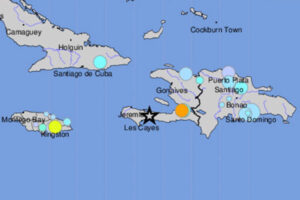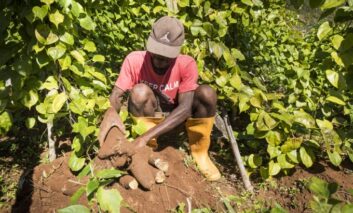Earthquake: 24,400 displaced people spread over 58 sites in the far South, according to IOM
On 14 August, a deadly, shallow earthquake rocked southwestern Haiti just 12km northeast of Saint-Louis du Sud, about 125 kilometers west of the capital Port-au-Prince. The quake severely affected buildings and homes and damaged critical infrastructure and roads, cutting off access to some areas in the southwest, such as national road 7, which connects Les Cayes and Jeremie. As of 18th August, the Haitian Civil Protection General Directorate (DGPC) reports more than 52,953 collapsed buildings and 77,006 in need of reparation, including at least 25 health facilities, 127 schools and 60 religious buildings so far. DGPC also reports at least 2,189 deaths and around 12,168 more injured, figures likely to increase significantly in the coming hours and days as more are still missing, and at least 650,000 people in need of humanitarian assistance. The Sud, Grand’Anse and Nippes departments, particularly the cities of Les Cayes, Jeremie and Anse-à-Veaux, were hardest hit, suffering extensive damage and destruction to buildings and homes, while in Petit-Trou-de-Nippes downed phone lines have left the city out of contact.
In response, IOM has activated its displacement monitoring tool, the Displacement Tracking Matrix (DTM) in the affected départements – Nippes, Sud and Grand’Anse – in close coordination with the General Directorate for Civil Protection (DGCP). The current DTM activities aim to gather basic information on possible displacement locations, assess damages sustained to buildings following the earthquake and understand mobility caused by this event.
Civil Protection and its partners change their strategy in distributing aid to earthquake victims
Alors que l’aide commence de plus en plus à arriver dans les trois départements ravagés par le tremblement de terre du 14 août 2021, les sinistrés dans les sections communales continuent de lancer des appels de détresse. Les zones les plus reculées dans le Sud, les Nippes et la Grand’Anse attendent toujours l’aide du gouvernement plus de 15 jours après la catastrophe. Face à cette situation, la Direction de la protection civile (DPC) annonce qu’elle va changer de stratégie.
Une distribution ciblée et ordonnée de l’aide dans les zones les plus touchées par le séisme, telle est la nouvelle stratégie de la Protection civile et de ses partenaires. « La Direction générale de la protection civile (DGPC) et plusieurs de ses partenaires – notamment l’armée américaine, l’USAID, l’Organisation internationale pour les migrations (OIM), l’Unicef et le Programme alimentaire mondial (PAM) –, ont opté pour la distribution ciblée et coordonnée de l’assistance dans les communautés affectées », révèle la Protection civile dans un communiqué, soulignant que ces six derniers jours, plus de 50 000 familles ont été atteintes grâce à cette stratégie.
« À ce jour, le Centre d’opérations d’urgence national (COUN), sous la coordination de la DGPC, de concert avec la Police nationale d’Haïti et avec l’appui du PAM, a réalisé 13 convois à partir de son entrepôt d’urgence pour un total de 145 véhicules, dont 94 camions. Des cargaisons de produits humanitaires sont hélitransportées de Port-au-Prince vers les communautés affectées. Elles sont ensuite remises aux maires, qui en assurent la distribution en compagnie notamment de policiers haïtiens et de volontaires de la Protection civile », a fait savoir la DGPC.
Civil Protection promises to step up efforts to best assist the population hit hard by the earthquake of August 14, 2021. It specifies that it organized, on Monday August 30, in concert with local structures and authorities, the distribution of humanitarian products for the benefit of 1,000 affected families, in Changeux, the 2nd municipal section of Azile in Nippes.
“Since the start of the response, the government, humanitarian and philanthropic actors, as well as individuals have transported hundreds of tons of goods to the great South where the earthquake affected more than 650,000 people”, indicated the Civil protection.
Among the products distributed to families affected by the disaster are food, water, tarpaulins, tents, woolen blankets, mosquito nets, among others.
Civil Protection underlines that it continues to accelerate response actions taking into account the mapping of landlocked areas, the urgent needs identified and the current hurricane season. “This week, operations will be conducted in Pestel, the Cayemites Islands, but also in several other municipalities of Grand’Anse where the aid will be delivered by boat,” promises Civil Protection.




